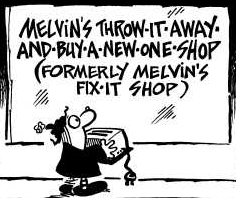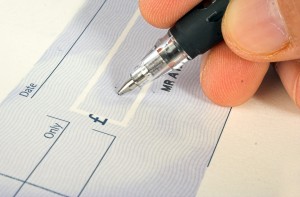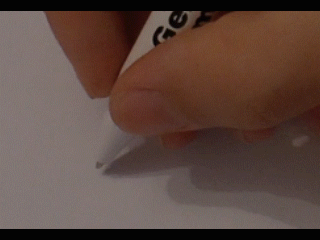This is not a blog post about pentesting, or any other kind of software-engineering inspired testing of pens. Nor is it a blog post about the kind of fascination some people have with pens and ink. Instead, this is a blog post about history and psychology.
Recently, JTA asked me what I do when I want to test a pen, and he was surprised with the answer. Before I tell you how I answered, I’ll tell you about what I learned from the conversation. And before that, I’ll tell you about the history of pen testing. And then, finally, I’ll tell you why I think it’s important from a psychological perspective.

Historically, the “breaking in” of a new pen was called a probatio pennae, literally “pen test”, and would typically be a few lines of text or a short proverb: something that demonstrated the pen’s ability to write. For the entire mediaeval period, plus several centuries besides, the principle instrument for writing would be the quill pen: the primary wing feathers of a large bird such as a goose, often hardened in hot ashes, stripped of barbs, and cut down to size with an blade whose purpose lends its name to what we now call a “pen knife”. With such a tool, a scribe would want to be sure that the pen could hold an adequate nibful of ink without splashing or spraying, and – despite the high value of paper – it was clearly essential to write a whole sentence or two to be sure.

A modern ballpoint pen has no such issues, but instead introduces some of its own: a plastic-lined inkwell can be gradually penetrated by the air, causing the ink to dry up; the ball can become stuck and will not turn freely; air bubble can develop within the tube (especially if the pen is stored, or worse-still used, the wrong way up); and, of course, the pen can run out of ink. This typically precipitates its disposal: your biro isn’t built to be re-used for anything except perhaps to perform an emergency tracheotomy, and it’s cheap enough that you don’t want to waste your time repairing it. As a result, our pen tests have become fast, designed to determine within a few seconds whether the pen we’ve got is working or, in the case of a stuck ball, can be made to start working with a sufficiency of scribbling. Our culture of disposal can’t spare the time for any more than a cursory test before we give up and grab the next one.

So what do we write? What is the probatio pennae of our times? It’s been widely-reported (although I can’t find any decent citations) that, upon being offered a new pen to try out, 97% of people will write their own name. Now that statistic smells fishy to me (no good citations anywhere, and 97% of people use 97% as their “virtually all” number, for made-up statistics), but I’ve been testing the hypothesis among friends these last few days, and I’ve gathered enough evidence to convince me that it’s probably the case that many or most people will write their own name to test a pen.

Somebody had presumably asked JTA what he wrote, earlier in the day, because he took the time to tell me that when he tests a new pen, he typically writes the word “hello”.
Now I find that pretty weird. Maybe it’s the software engineer in me, but to me the mark of a good test is that it covers all of the possible cases, in the minimal possible effort. Writing your name is easy because it’s managed by what is popularly-called “muscle memory”: a second-season episode of Castle (correctly) used this as a plot point, when a man suffering from retrograde amnesia was unable to remember his name, but was still able to sign his name because the act of signing it had been rendered, by years of practice, into his procedural memory, which was unaffected by his condition. But writing a word, like “hello”… requires a comprehension of language. Unless he’s tested enough pens to have built a procedural memory of writing “hello” to test pens, JTA’s test has a greater number of neural dependencies, which – with apologies to those of you who aren’t interested in automated software testing – produces what we’d call an unnecessarily “brittle” test.

Me? I just scribble, which my quick survey (and several comparable ones online) show to be probably the second-most popular action to test a pen. Scribbling, to me, simply seems like the minimal test path: the single simplest thing that can be done with a pen that will demonstrate that it’s fit for purpose. I don’t need to test that a new pen can write words, because – to me – writing words in particular is not a function of the pen, but a function of my brain! To me, the pen’s function is simply one of transferring ink to the paper, and any semantic meaning coming from the ink is a product of my intellect, not of the writing implement.
So why is this important? Well: I have a half-baked hypothesis that the choice of what to write with a new pen might be linked to other aspects of our psychology. When I’m developing a new template for a website, for example, I use lorem ipsum text and dummy placeholder images as filler (just occasionally, I’ll use kittens, because kittens are adorable). That’s because the absence of meaning to the words that appear (I don’t read Latin, and even if I did, lorem ipsum is frequently mangled) has no bearing on my comprehension of the design: and, in fact, it can sometimes be a benefit to be deprived of the distraction of legible content.

But I’d hypothesise that people who write words as a probatio pennae would be less-comfortable with illegible placeholder-text in a design than those who drew scribbles or signed their name. I have a notion, from my own experience, that the same parts of the brain that is responsible for judging the quality of a writing implement are used in the judgement of a piece of design work. Hey: maybe if that’s true, graphic designers should have their clients test pens out, in their presence, before they decide whether to use believable filler or lorem ipsum text in the designs they’d like approved.
Or maybe I’m way off base. What do you write when you test a pen?
When testing a fountain pen or a dip pen I write: The quick brown fox jumps over the lazy dog.
Which is very much a test of writing, and that is after all what the pen is going to be used for.
If using a ball point, or a pen that has not put down ink on the first stroke I doodle.
A dip pen shares many of the characteristics of a quill pen, of course – functionally it’s identical, and a non-functioning one would fail in a similar way, spraying ink all over your manuscript: not good! As a result, I can see how you’d want to test it in a more-thorough and more realistic manner than you would a biro.
A fountain pen… less so. But I can still see how somebody with an interest in pens and ink, like you, would pay more attention to such things. And perhaps you just have a more-refined taste in these things, than I, and would pay attention to the subtle lift and fall of thinner and thicker lines produced as the pen is moved, for example. Me? I’m more of a utilitarian pen-user.
‘Hello’ is a really useful word to write. I do make a couple of squiggles first to get the ink flowing again, especially if I’ve not used the pen for a bit, but ‘hello’ is mostly up and down strokes, so you can see how the nib feels, and if the tip is likely to catch on the paper.
Plus the double-loop of the consecutive ls is good to see how bad the bleed is, and mimics the curve of the higher and lower-curved letters (f, g, y), and the word is short enough that you can write it one-handed without needing to lift you hand off the page, or steady the paper.
(I agree that the pen is there to get the words down, but the point of testing a pen is first to make sure that the ink flows nicely and second to make sure the pen itself has been well-designed. If it’s all weird corners, or has a weirdly smooth grip, or has been created by someone labouring under the misapprehension that what the world needs is a really, really fine-nibbed ballpoint of all things, you’re going to be all over the place. I always feel it’s easier to test against that if you write an actual word rather than making random squiggles; how can you tell if a squiggle came out wrong?)
Having said all that, yeah, when I design pages (admittedly rarely) I’m much more likely to have a nearly empty page that says “Information on page subject goes here” than to fill it with Lorem Ipsum, because a page full of nonsense text is a slightly more effort than a simple statement of intent, and doesn’t seem to add anything…
You make a valid point about the direction of the strokes, and I’ve noticed that, while experimenting on myself with every pen I’ve picked up in the last week or so, my “scribble” isn’t without pattern or form: it begins with harsh, straight, zigzag lines (often in a bottom-left/top-right diagonal pattern which I assume is because I’m right-handed) and then devolves quickly into a more-curved and spiraling pattern which is perhaps more-representative of the art of writing. You can just about make out me doing a little bit of it in the third section of the animated GIF in the post.
(I also really appreciate the thought you’ve put into justifying your “hello”!)
Perhaps this “scribble” is an abstract representation of my internal concept of “writing”? Now I want to gather up a corpus of people ‘scribbler’-variety pen-testers and a graphologist and compare the nature of their scribbles to the type of their handwriting! Is there a correlation between my messy scribbles and my unstructured handwriting (which has always been poor, even before I used to type virtually everything!)? If so, would be expect scribblers with a more-careful cursive hand to make more-careful scribbles, or even repeat a particular doodle (while researching online, I found a handful of people who draw smiley faces as a test of a pen: I wonder what their handwriting is like?).
A while back, Matt in the Hat expressed an interest in graphology. I wonder what he thinks of all this.
After reading a book on graphology I took it at face value and wrote my post. In the wake of Jimmy’s comment I took a cursory glance over the research and found it flawed in regards to handwriting being linked to personality traits. I then also found that the author also wrote books on astrology and numerology. Forensic graphology is sound though.
Over the last year I’ve made an effort to change certain aspects of my handwriting. Maybe I should write about it in my blog…
When trying out pens in stationary stores I usually write “今日は” (konnichiwa) in the hope that anyone that can read it will appreciate coming across a little snippet of Japanese randomly.
Somebody I asked today about their habits said that while they usually scribble if they just want to check if a pen they own works, if they’re in a shop and considering the purchase of a pen they’ll always write exactly what they’re thinking, which usually amounts to “is this pen the right one for me?”
I scribble loopy spiral things. Unless I’m trying to get the pen to work, in which case it’s huge up and down zig-zags.
I’m also a random scribbler.
I wonder if this tendency is related to another one I’ve noticed pen users tend to ‘do’ or ‘not do’ and that’s to use the pen to ‘doodle’ during periods when they aren’t writing. Do ‘scribblers’ also ‘doodle’ and ‘writers’ only ‘write’???
In terms of testing a pen, though, I’d say there are some other attributes I include that make a particular (even if cheap) pen either more or less desirable. For me, for example, I prefer to be able to ‘see’ how much ink I’m getting/have left so a transparent case is useful – and I would usually choose a pen that allows the nib to be covered (retraction or cap) as this can help prevent ink-related accidents in pockets. Although not ‘tests’ as such, this sort of checking functionality can be as valuable as knowing the ink flows. And then there are the finer details of flow rate, how the pen feels to use, what colour the ink is……… deary me someone could write a thesis on the selection of pens……
When testing a pen in a store, I write the name of the pen followed by a few loops. When testing a pen at home, I do the same plus write out the whole alphabet (upper & lowercase) in my current notebook. That way, I can gauge how a particular pen (or pen + ink combo) performs on my paper of choice.